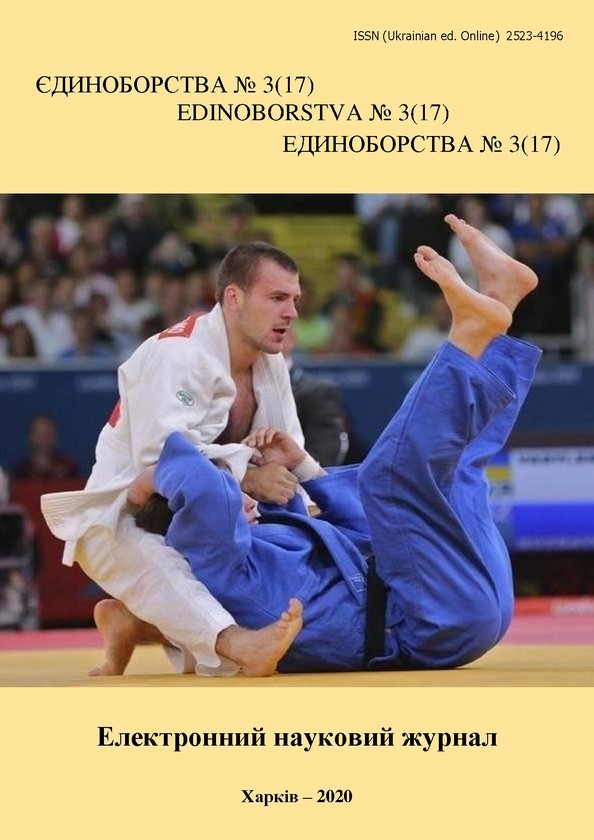Дослідження рівня прояву тривожності та сенсомоторних реакцій таеквондистів-юніорів
DOI:
https://doi.org/10.15391/ed.2020-3.07Ключові слова:
тривожність, психічний стан, сенсомотрна реакція одноборства, взаємозв’язок, таеквондисти-юніориАнотація
Мета: визначити рівень особистісної, ситуативної тривожності та сенсомоторних реакцій таеквондистів-юніорів. Матеріал і методи. У науковому дослідженні приймали участь таеквондисти-юніори (15,3±0,14 років) спортивного клубу «Білий ведмідь», у кількості 17 спортсменів (кваліфікація: МС-3, КМС-14). Для диференційної оцінки рівня тривожності було використано методику Спілбергера-Ханіна. Методика Спілбергера-Ханіна є інформативним способом самооцінки рівня тривожності в даний момент (реактивна триаожність, як стан) і особистісної тривожності (як стійка характеристика людини). Для оцінки сенсомоторних реакцій використовувався інструментальний метод. Спеціалізовані тестові програми для планшетних комп'ютерів: визначення реакції вибору; оцінка короткочасної зорової пам’яті. Результати: вивчення взаємозв’язків між проявом реакції вибору та короткочасної зорової пам'яті у спортсменів, які приймали участь у дослідженні, з рівнем прояву їх ситуаційної тривожності показало наскільки одноборці володіють здібністю аналізувати свій психічний стан. Аналіз цих взаємозв’язків на першому тестуванні свідчить, що не всі спортсмени можуть точно оцінити свій особистий рівень ситуаційної тривожності. Так, для такого показника, як відсоток точних натискань статистично значимий взаємозв'язок склав r=0,18; для часу зорової реакції на візуальні сигнали при вимірюванні короткочасної зорової пам'яті r=0,44; для часу реакції вибору r=0,18. Причиною слабких статистично значимих взаємозв'язків є відсутність досвіду оцінки свого психічного стану спортсменами, які приймали участь у досліджені. Результати другого тестування, свідчать, що є статистичні значимі взаємозв’язки між рівнем прояву ситуаційної тривожності та психофізіологічними показниками. Так, для відсотку точних натискань r=0,66; для часу зорової реакції на візуальні сигнали при вимірюванні короткочасної зорової пам’яті r=0,76; для часу реакції вибору r=0,68. Висновки. Дослідження прояву тривожності має велике значення з точки зору оптимізації психологічної підготовки таеквондистів-юніорів. Визначенні показники особистісної та ситуативної тривожності та показники сенсомотрних реакцій. Так, рівень особистісної тривожності таеквондистів-юніорів склав 32,4±9,42 балів, рівень реактивної тривожності 33,9±6,93 балів. Вимірювання короткочасної зорової пам'яті та реакції вибору таеквондистів-юніорів на першому та другому тестуванні не мають статистично значимих розбіжностей між показниками (р>0,05). На підставі аналізу взаємозв’язків між досліджуваними показниками визначено, що використання одночасно методів оцінки рівня прояву тривожності та сенсомоторних реакцій дозволяє отримати об'єктивні дані, щодо характеристики ситуаційного психічного стану одноборця.
Посилання
Алексеев, А. Ф. (2010). Моделирование тренировочных заданий в единоборствах. Физическое воспитание студентов, 3-7.
Арзютов, Г. Н. (1999). Многолетняя подготовка в спортивных единоборствах. НПУ им. М. П. Драгоманова, Киев.
Ашанин, В. С, & Романенко, В. В. (2015). Использование компьютерных технологий при оценке сенсомоторных реакций в единоборствах. Слобожанский науково-спортивнии сбірник, No4 (48), 15-18.
Волков, И. П. (2002). Практикум по спортивной психологии. СПб.: Питер.
Воронова, В. И., Федорчук, С. В., Тукаев, С.В., Лысенко, Е. Н., & Шинкарук О. А. (2017). Психофизиологическое состояние спортсменов с разным уровнем личностной и ситуативной тривожности в сложнокоординационных видах спорта. Спортивна медицина і фізична реабілітація, № 1, 26-32.
Горностай, П. П. & Титаренко, Т. М. (2001). Психологія особистості: Словник довідник. Рута, Київ.
Ильин, Е. П. (2012). Психология спорта. СПб.: Питер.
Осадець, М. М. (2014). Психологічна підготовка особистості в спорті. Наукова педагогична думка, науковий журнал, №4, 155-157.
Павлик, О. М., & Вакуленко, Д. О. (2011). Особенности тривожности у эмоционально устойчивых и неустойчивых кикбоксеров. Слобожанський науково-спортивний вісник, №4, 266-268.
Прихожан, А. М. (2007). Психология тривожности. СПб.: Питер.
Ровный, А. С., & Романенко В. В. (2016). Модельные характеристики сенсомоторных реакций и специфических восприятий единоборцев высокой квалификации. Единоборства, №1, 54-57.
Романенко, В. В. (2017). Современные компьютерные технологии в профессиональной деятельности единоборцев (методические рекомендации). ХГАФК, Харьков.
Романенко, В. В., Голоха, В. Л., & Веретельникова, Н. А. (2018). Оценка и анализ подготовленности квалифицированных тхеквондистов. Единоборства, No 1, 58-69.
Романенко, В. В., & Ровный, А. С. (2016). Модельные характеристики сенсомоторных реакций и специфических восприятий единоборцев высокой квалификации. Единоборства No1, 54-57.
Романенко, В. В, & Голоха, В. Л., & Веретельникова, Н. А. (2018). Особенности проявления кратковременной зрительной памяти у единоборцев ХГАФК. Единоборства, No 4, 33-41.
Рудик, П. А. (2010). Психологические аспекты спор¬тивной деятельности. Психология и современный спорт. 101-105.
Ханин, Ю. Л. (1991). Межличностная и внутригрупповая тревога в условиях значимой совместной деятельности. Вопр. Психологии, № 9, 56–64.
Ханин, Ю. Л. (1976). Краткое руководство к применению шкалы реактивной и личностной тривожности Ч. Д. Спилбергера. Л. ЛНИИТЕК, 56-61.
Iermakov, S., Podrigalo, L., Romanenko, V., Tropin, Y., Boychenko, N. & Rovnaya, O. (2016). Psycho-physiological features of sportsmen in impact and throwing martial arts. Journal of Physical Education and Sport, Vol. 16(2), 433-441.
Rovnaya, О, Volodchenko, О., Podrigalo, L., Aghyppo, О., & Romanenko, V. (2018). Comparative Analysis of a functional state of martial arts athletes. Journal of Physical Education and Sport, T17, No 3, p 2142-2147.













